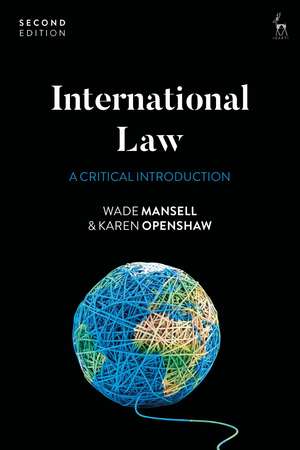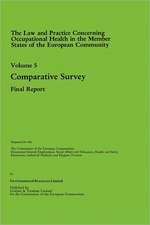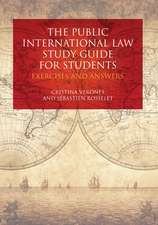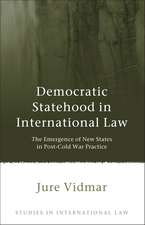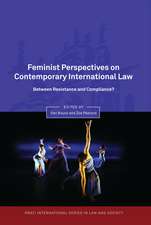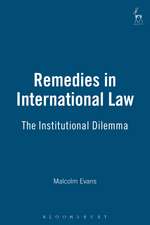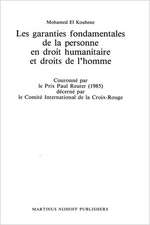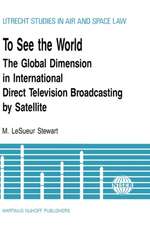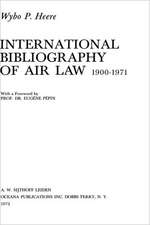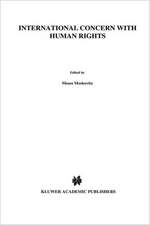International Law: A Critical Introduction
Autor Wade Mansell, Karen Openshawen Limba Engleză Paperback – 21 aug 2019
Preț: 164.88 lei
Preț vechi: 189.08 lei
-13% Nou
Puncte Express: 247
Preț estimativ în valută:
31.55€ • 33.19$ • 26.33£
31.55€ • 33.19$ • 26.33£
Carte disponibilă
Livrare economică 19 decembrie 24 - 02 ianuarie 25
Livrare express 04-10 decembrie pentru 61.46 lei
Preluare comenzi: 021 569.72.76
Specificații
ISBN-13: 9781509926725
ISBN-10: 1509926720
Pagini: 408
Dimensiuni: 156 x 234 x 27 mm
Greutate: 0.66 kg
Ediția:2
Editura: Bloomsbury Publishing
Colecția Hart Publishing
Locul publicării:London, United Kingdom
ISBN-10: 1509926720
Pagini: 408
Dimensiuni: 156 x 234 x 27 mm
Greutate: 0.66 kg
Ediția:2
Editura: Bloomsbury Publishing
Colecția Hart Publishing
Locul publicării:London, United Kingdom
Caracteristici
Taking a very applied approach, the new edition looks at contemporary concerns such as self-determination and sanctions
Notă biografică
Wade Mansell is Professor Emeritus at the Unviersity of Kent. Karen Openshaw holds a PhD in international law from the University of Kent.
Cuprins
Introduction I. International Law and Domestic Law II. Paradoxes in the Contemporary World III. Law and Power IV. The Structure of the Book 1. The Distinctive Nature of International Law I. What is International Law? II. How International Law Differs from Domestic Law III. The Changing Nature of International Law IV. International Law and Common Sense V. What Makes International Law 'Law'? VI. Why is it Necessary to Identify the Sources of International Law? 2. The Dynamic Quality of International Law I. Introduction II. The Concept of Sovereignty and Sovereign Equality III. The Concept of Sovereignty and Jurisdiction IV. Sovereignty and Controversial Bases of International Jurisdiction V. Sovereign Equality and the Concept of Universal Jurisdiction VI. Immunity from JurisdictionVII. Legal Personality in International Law VIII.The Place of the Individual in International Law IX. The Individual in International Law as Exemplified by the European Convention on Human Rights.. X. The Interrelationship between Sovereignty, Personality and the Individual in International Law 3. Self-determination and Territory in International Law I. Introduction II. The Concept of Self-determination in International Law before the Creation of the United NationsIII.The United Nations Charter, Self-determination and Decolonisation IV.Self-determination after the Cold War V. States, Territory and Recognition VI.Territorial and Other Rights Over the Sea and its Bed VII. Conclusion 4. The International Obligations of States: Treaties and State Responsibility I. Introduction II. The Law of Treaties III.State Responsibility in International Law IV.Conclusion 5. The United Nations, the UN Charter and International Law I. Introduction II. The Origins of the UN III.The Structure of the UN IV.How the UN is Financed V. The UN Charter: A Constitution for the World? VI. Conclusion 6. Human Rights in International Law I. Introduction II. What are Human Rights? III.The Politics of Human Rights IV.The International Bill of Human Rights V. Other Principal UN Human Rights Conventions and Bodies VI.Regional Protection of Human Rights VII. The International Criminal Court VIII.Conclusion 7. The Peaceful Settlement of Disputes in International Law I. Introduction II. Legal Method and International Dispute Resolution III.The International Court of Justice IV. International Arbitration V. Conclusion 8. Use of Force in International Law I. Introduction II. The Use of Force in International Law before the Creation of the UN III.The Charter of the UN IV.Chapter VII of the UN Charter V. Self-defence in International Law VI.From Humanitarian Intervention to Responsibility to Protect VII. Rules Constraining the Type of Force Permissible VIII. Conclusion 9. The Misery and Grandeur of International Law I. Introduction II. The Paradox of Sovereign Equality III.The United States of America and International Law IV.The Case of Israel and International Law V. Conclusion
Recenzii
The book is highly successful in its stated goal of providing a critical introduction to international law; one that foregrounds (rather than, as is customary, backgrounds) the operation of power and politics deep within the discipline itself and international law's deep connectedness to the (usually asymmetrical) exercise of power.
The first edition to this wonderful work promised that its critical approach would be "skeptical rather than cynical". In analysing international law through a political lens, it was extremely successful. I am delighted that the publishers have had the foresight to commission a second edition to enlighten us all.
International Law: A Critical Introduction reaches below the surface of international law to interrogate the assumptions on which the system rests and bring to light its intimate connections with power. The work deepens our understanding of grand projects of global regulation through law, their capabilities and ultimate constraints.
This text provides an effective and efficient compass for the reader to navigate the current contemporary international law landscape. The text is easily read, and international legal principles are clearly and lucidly explained in a way which is commensurate with their complexity. The book covers the traditional topics of an international law module but the critical analysis of the exposition provides insight by painting with a broad brush the international political background against which law is played out. International Law: A Critical Introduction is welcome and timely.
This is a welcome addition to public international law scholarship. There is much to criticise in international law's conventional representation as a politically neutral, rules-based system that often contrasts sharply with practice, and this book does well to peel off the layers of dogma to reveal a credible portrayal of the subject in terms of its ambitions, actors and methods.
A fresh and realistic approach to international law not seen in most traditional textbooks . this book provides fresh balance in its approach to the relationship between international law and power politics.
The first edition to this wonderful work promised that its critical approach would be "skeptical rather than cynical". In analysing international law through a political lens, it was extremely successful. I am delighted that the publishers have had the foresight to commission a second edition to enlighten us all.
International Law: A Critical Introduction reaches below the surface of international law to interrogate the assumptions on which the system rests and bring to light its intimate connections with power. The work deepens our understanding of grand projects of global regulation through law, their capabilities and ultimate constraints.
This text provides an effective and efficient compass for the reader to navigate the current contemporary international law landscape. The text is easily read, and international legal principles are clearly and lucidly explained in a way which is commensurate with their complexity. The book covers the traditional topics of an international law module but the critical analysis of the exposition provides insight by painting with a broad brush the international political background against which law is played out. International Law: A Critical Introduction is welcome and timely.
This is a welcome addition to public international law scholarship. There is much to criticise in international law's conventional representation as a politically neutral, rules-based system that often contrasts sharply with practice, and this book does well to peel off the layers of dogma to reveal a credible portrayal of the subject in terms of its ambitions, actors and methods.
A fresh and realistic approach to international law not seen in most traditional textbooks . this book provides fresh balance in its approach to the relationship between international law and power politics.
